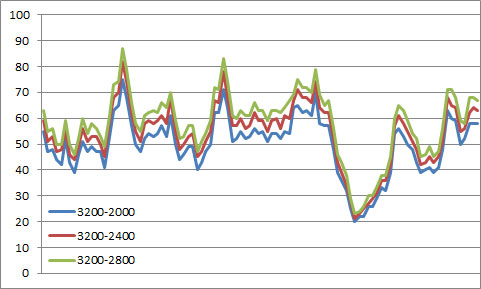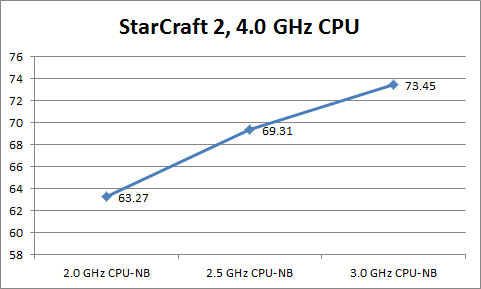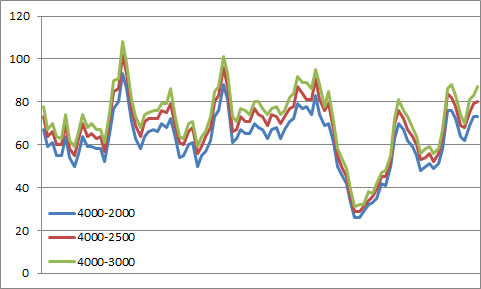ASRock 890FX Deluxe: Comprehensive Motherboard Review & Investigation of Thuban Performance Scaling
by Rajinder Gill on August 31, 2010 7:00 AM EST- Posted in
- ASRock
- AMD
- Motherboards
- 890FX
To find out how the CPU-NB affects the performance, we picked three data points each for our 1090T’s stock frequency (3.2 GHz) and for overclocked frequency (4.0 GHz). Ideally we wanted to control memory ratio, frequencies and timings, but the data size became quickly too large for this review. In the end we decided on some of the key data points so that users can easily understand the impact of the CPU-NB and memory configuration on this platform. For these tests, we disabled Window’s power saving features and 1090T’s Turbo Core. Keep in mind that these tests were not performed as a comparison between different products, so the data here cannot be directly compared to numbers you may see elsewhere. Games were run at 1680x1050 in full-screen mode with maximum in-game settings. AA and AF were disabled.
Stock Configuration (1090T, 3.2 GHz)
3200-2000: CPU 3.2 GHz, 16x200 | CPU-NB 2.0 GHz, 10x200 | 2x2GB DDR3-1066/CL5
3200-2400: CPU 3.2 GHz, 16x200 | CPU-NB 2.4 GHz, 12x200 | 2x2GB DDR3-1333/CL6
3200-2800: CPU 3.2 GHz, 16x200 | CPU-NB 2.8 GHz, 14x200 | 2x2GB DDR3-1600/CL7Overclocked Configuration (1090T, 4.0 GHz)
4000-2000: CPU 4.0 GHz, 16x250 | CPU-NB 2.0 GHz, 8x250 | 2x2GB DDR3-1333/CL6
4000-2500: CPU 4.0 GHz, 16x250 | CPU-NB 2.5 GHz, 10x250 | 2x2GB DDR3-1666/CL7
4000-3000: CPU 4.0 GHz, 16x250 | CPU-NB 3.0 GHz, 12x250 | 2x2GB DDR3-2000/CL8


The 7-Zip benchmark does set the trend of what’s to come. Note we had to stretch the charts in order to keep the numbers legible. It looks like the performance gain is almost linear at 3.2 GHz while it tapers off somewhat as we raise the CPU-NB from 2.5 GHz to 3.0 GHz at the core frequency 4.0 GHz. The improvements from the default CPU-NB frequency 2.0 GHz ring at 3.5% and 5%, respectively.
X264 HD 3.0 Benchmark


We ran the latest version of X264 HD 3.0 benchmark five times, and averaged the middle three scores. X264 HD 3.0 benchmark results are interesting. We see slightly better scaling than 7-Zip for the 1st pass (FPS increases by 4.2% and 5.4%, respectively) , but the improvement in 2nd pass was almost non-existent. We are starting to wonder whether it is worth raising the CPU-NB frequency because the gain pales in comparison to the gain made by increasing the core frequency. Simply overclocking the CPU core by 25% without touching the CPU-NB got us 20% performance improvement in the 2nd pass.
H.A.W.X.


Finally we are seeing some impressive gains. We are using the game’s built-in benchmark at 1680x1050 with in-game graphics options set to maximum in DX9 mode. This game is not known for particularly being CPU-bound, so we are seeing ridiculously high frame rates here. At the same time, the gains made by overclocking the CPU-NB seemed too good to be true, 3.2 GHz CPU / 2.8 GHz CPU-NB combo surpassing 4.0 GHz CPU / 2.0 GHz CPU-NB combo. We ran the benchmark over 10 times on both ASRock’s 890FX Deluxe 4 and the ASUS M4A89GTD Pro/USB3 and the trend was the same, CPU-NB overclocking benefiting the game as much as, if not more than, the CPU core overclocking. Overclocking CPU by 800 MHz nets an 8% improvement in FPS, yet overclocking CPU-NB by 800 MHz got us 9% FPS increase.
This was a completely unexpected result after the 7-Zip and X264 benchmarks, so we had to turn to a game that’s known to be more stressful to CPU. Enter StarCraft 2.
StarCraft 2
This game needs no introduction. We are using a 38 minute replay file and let it play throughout from a player’s point of view to ensure the game data stays in the memory. We then go back and measure the 5 minutes of the battle near the game’s end using FRAPS utility. We set the resolution at 1680x1050 and in-game quality options at maximum.




It was quite disorienting to watch the player’s frantic mouse clicks and keyboard tapping while the camera followed the commands (and 130+ Zerglings). Nevertheless, we had to take many disorienting trips in order to ensure the reliability of our results. We ended up running many more replays countless times and played the game ourselves, and conclude the results are valid.
Both at 3.2 GHz and 4.0 GHz, the CPU-NB overclocking yielded 16% more performance in this game without moving an inch of the CPU frequency. Of course in both the cases the CPU-NB overclocks were massive - 40% at 3.2 GHz and 50% at 4.0 GHz. Whatever conclusion you draw from these tests, one thing is for sure: If your X6 CPU feels sluggish in StarCraft II, overclock its CPU-NB and memory.










42 Comments
View All Comments
Kane Y. Jeong - Wednesday, September 1, 2010 - link
We disabled Turbo Core for maximum overclocking. vCore was measured by a DMM.softdrinkviking - Wednesday, September 1, 2010 - link
nice review, good read.one thing I noticed, in your chart comparing the 890FX and 790FX, it says "TMSC 65nm," i am thinking that should be "TMSC 45nm."
or maybe i'm crazy, or maybe both are true?
softdrinkviking - Wednesday, September 1, 2010 - link
or is that the AMD890 chipset manufacturing process that's at 65nm?pkc - Wednesday, September 1, 2010 - link
I believe that it should be compared with ASUS M4A89TD Pro/USB3 and Gigabyte GA-890FXA-UD5 which are using the same chipset i.e. 890FXMacLeod1592 - Wednesday, September 1, 2010 - link
I currently run an ASRock 780G motherboard and was hoping theyd stepped it up a notch. My board also overvolts the CPU when I overclock. Its always a notch or two higher in CPU-Z than what I set it to in the BIOS.Mines also not a great overclocker. I cant get my Athlon X3 435 over 3.4 but all the reviews Im seeing have it at 3.6 and better!
Looks like Asus will be getting my money in the near future when I upgrade mobos.
siniranji - Thursday, September 2, 2010 - link
my question is , which thuban processor will perform well with this board, i have 1055T modelMrSpadge - Saturday, September 4, 2010 - link
Can I comment now?MrSpadge - Saturday, September 4, 2010 - link
Ups, that was unexpected. On to my actual comment regarding:"We have no conclusive theory to explain this phenomenon at this time. Originally our suspicion was limited to CPU-NB’s frequencies and memory frequencies/timings, but now we wonder whether the size of L3, which is meager 1MB per core for the X6’s, comes into play as well. We are looking to further examine this subject in the future."
Naturally modern games have very complex scenes so the CPU has to deal with a lot of data. Which data is not entirely predictable & prefetchable, so the CPU absolutely needs large caches. In fact, the caches can hardly be large enough - so main memory bandwidth and latency matters.
The encoding on all 6 cores on the other hand is a very regular task and the memory requests are quite predictable. The programmer or and / the cpu prefetchers are working to keep all the data in the caches before they are needed.
Or put empirically: If the app is programmed so well that it scales well from 4 to 6 cores [your encoding does], memory access can not be a problem here. And thus faster memory doesn't help much.
Regards, MrS
geok1ng - Monday, September 6, 2010 - link
There we have it again, a seminal article that will be quoted around the web for months to come.This easy to read article is the most complete and compreensive guide to AM3 plataform overcloking, and deserves to join the now famous "why we were wrong about the P45 chipset" article on C2D memory overcloking and the SSDs series.
To give you guys an example of the importance of NB overcloking on these AMDs hexacores, Tom Hardware´s has an article on the system builders marathon today that shows a 1055T system with SLI 480s. Th build fails to impress by about 20% agains a similar priced $2000 Intel system, and guess what? TH makes no mention of NB overclock!
RealTheXev - Friday, September 10, 2010 - link
I've run into several people who have had a 8xx series AMD chipset but have run into an issue of having an SB750 southbridge instead of the SB850.http://www.starcraft2forum.org/forums/showthread.p... for my write up.
My question is, will Asus be addressing this issue by adding the SB750 to their chipset drivers? Also, will this board possible be substituted for an SB750 southbridge as well? If so, I want to know the performance difference!
Asus isn't the only manufacture substituting the southbridge. I'm curious about the difference between the SB850 and SB750 variants of these boards and how likely it is a user will end up with one of these boards "substituted" boards.